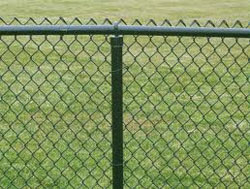By weaving galvanized steel wire into interlocking squares, manufacturers can create chain link fencing. By securing this material to steel posts that are firmly embedded into the ground, you can install a fence to enclose a yard, playground, parking lot, industrial property, baseball field, construction site or animal pen. Chain link fencing is suitable for almost any purpose and because it is flexible, it can be formed into any border outline.

Chain Link Gauges and Diameters
The wires on any given chain link fencing material are available in several thicknesses, or gauges. The thickness of the wire will be indicated by the gauge number. Thicker chain link is more expensive. Typically, chain link fences come in 11 gauge, which is thin, 10 gauge, which is a little more thick, and 9 gauge, which is more thick.
The chain link mesh's diameter will also be indicated on the packaging. This number is formulated by measuring both diagonal sides of one square within the mesh. One common diameter of chain link fencing is two inches. This size is usually reserved for fences with a 9-11 wire gauge.
Chain Link Coatings, Slats and Covers
Some chain link fencing is coated in PVC vinyl, which looks much like a rubber sheath. In order to create a smooth, permanent finish, the PVC will be thermally fused together and bonded. This coating is designed to prevent the fence's metal from rusting and is available in different colors.
If privacy is a concern for you, some chain link fencing has pre-installed slats. These slats are simply plastic rails that are woven into the fencing material. Because slats do no form a complete barrier, they will only give you partial privacy. Slats can be retrofitted to an existing chain link fence. Just like PVC-coated chain link, slats are available in various colors.
If you want additional privacy, consider attaching a windscreen to your chain link fencing. Windscreens do not only offer privacy but also block wind. This material is measured by its weave opening, which ranges from 70-90 percent. This material is made from several different kinds of fabrics. Aluminum grommets and bonded seams help secure a windscreen to a chain link fence.
Constructing a Chain Link Fence
Chain link fencing material can be purchased in rolls that start at 50 feet. When installing chain link fencing, you will need to embed line post in the ground at even intervals. The intervals will depend on the fence's length, height and other factors. When digging for the posts, the holes must be "bell-bottomed." After the holes are dug, concrete has to be poured and then, the posts can be set into the concrete.
For gates and corners, terminal posts must be used. By using tension bars that are aligned in a horizontal fashion, you can create top rails for the chain link fencing. Once it is time to attach the actual chain link material, you will need to use a come-a-long or fence stretcher in order to tightly stretch the fabric. The fabric should be secured to each post with steel bands.
